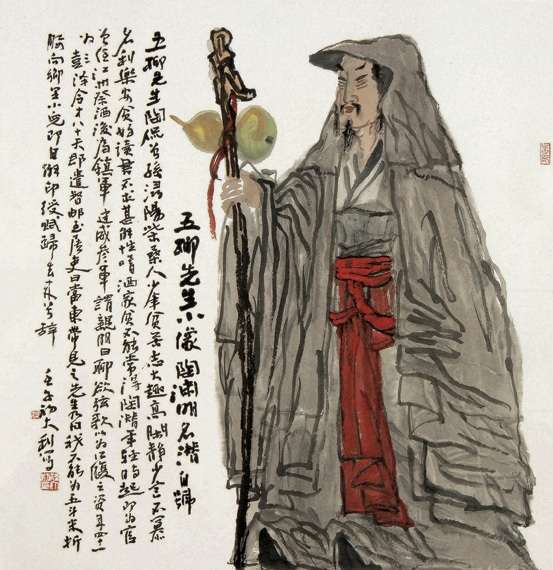Culture and Art in Western Jin and Eastern Jin
西晋和东晋时期的文化艺术
In the world of literature, Lu Ji(261—303) and Zuo Si(250—305) of the Western Jin excelled in poetry.
文学世界中,西晋时期的陆机(261——303)和左思(250——305)擅长诗词歌赋。
Lu Ji’s special treatise On Poetry Writing, contributed to the development of China’s literary though.
陆机的代表作《文赋》为中国文学的发展贡献巨大。
The Ode to the Three Capitals (of the Three Kingdoms), written by Zuo Si in a vigorous style,created such a stir among the men of letters that it was copied and passed from hand to hand, causing a shortage of paper supply in the capital city of Luoyang.
左思风格遒劲的《三都赋》在文人墨客中引起轰动,他的作品被不断印刷与传送,一时之间引得洛阳纸贵。
Tao Yuanming(365—427),the poet and prose writer of the Eastern Jin,was famous for his five-character poems full of poetic imagination and the flavor of rustic life.
东晋时期的诗人与散文家陶渊明(365——427)以他富有诗意想象和乡村生活趣味的五言诗而闻名。
Formerly an Eastern Jin official, Tao Yuanming resigned after becoming disillusioned with the corrupt government to lead a secluded life in the countryside.
陶渊明以前是东晋的一位官员,他在对于腐败的政府不再抱幻想之后辞去了官职,在乡村过上了隐居的生活。
His outstanding prose piece, Peach Blossom Stream, a description of a Chinese Arcadia, expressed his longing for a society without power struggle, cut-throat competition, lying and cheating.
他著名的散文诗《桃花源记》是对于中国世外桃源的描写,这首诗表达了他对于一个没有权力斗争、残酷竞争、谎言与欺骗的社会的向往。

During the Western and Eastern Jin period, the pian ti wen (a flowery antithetic style of writing) was very popular. It was gorgeous in form but lacked depth.
在西晋和东晋时期,骈体文(一种华丽的对偶写作风格)非常流行。
Calligraphy and painting reached a high level of development in the Eastern Jin.
骈体文的形式绚烂但内容缺乏深度。
Wang Xizhi (321—379 or 306—361) absorbed the essence of calligraphy of the Han-Wei period and created a style of his own to earn his fame as the “Sage Calligrapher”.
书法与绘画在东晋时期发展至顶峰。
Gu Kaizhi (345—406) was noted for his portraits of human figures with highly expressive eyes.
王羲之(321——379或306——361)吸取了汉魏时期书法的精髓并形成了自己的风格,他因此被称为“书圣”。
The mural painting of Vimalakirti, a lay Buddhist, done for the Waguan Temple of Jiankang, impressed art-lovers with its brightly coloured and finely drawn lines.
顾恺之(345——406)以具有极度传神的眼睛的人像画而闻名。
His work, On the Art of Painting, was a masterpiece on painting techniques.
他为建康瓦官寺所画的维摩诘壁画“维摩诘像”的明亮色彩和流畅线条使艺术爱好者记忆深刻。
The Western and Eastern Jin period turned out more historical works than ever.
顾恺之的著作《论画》是谈论绘画技巧的杰出之作。
There were an outpouring of history books on the Eastern Han, the Three Kingdoms, the Jin and the Sixteen States,
西晋和东晋时期涌现出了大量的史学作品,有关于东汉、三国还有晋朝和十六国时期的作品呈井喷状态,
notably the History of the Three Kingdoms by Chen Shou (233—297), An Extension of the History of the Han Dynasty by Sima Biao (? —306) and Records of the Later Han Dynasty by Yuan Hong (328—376).
其中最著名的是陈寿(233——297)所著的《三国志》、司马彪(?——306)所著的《续汉书》和袁宏(328——376)所著的《后汉纪》。
The History of the Three Kingdoms enjoys a fame only next to that of Records of the Historian and History of the Han Dynasty.
《三国志》的出名程度仅次于《史记》和《汉书》。
Written in biographical form, it describes the rise, growth and fall of the Three Kingdoms.
它以传记的形式描写了三国的出现、发展与覆灭。
An Extension of the History of the Han Dynasty originally had 80 juan but only 30, about the institutions and statutes of the Eastern Han Dynasty, survive.
《续汉书》原先有80卷但现在仅存有关东汉时期政策与法令的30卷。
Records of the Later Han Dynasty, annals of the Eastern Han,shows innovation in the preservation and compilation of historical material.
《后汉纪》作为东汉时期的编年史展现了历史资料保存于编辑上的创新。


